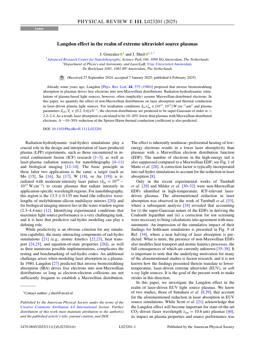2025-02-06
Langdon effect in the realm of extreme ultraviolet source plasmas
Publication
Publication
Phys. Rev. E , Volume 111 - Issue 2 p. L023201: 1- 6
Already some years ago, Langdon [Phys. Rev. Lett. 44, 575 (1980)] proposed that inverse bremsstrahlung absorption in plasmas drives free electrons into non-Maxwellian distributions. Radiation-hydrodynamic simulations of plasma-based light sources, however, often (implicitly) assume Maxwellian-distributed electrons. In this paper, we quantify the effect of non-Maxwellian distributions on laser absorption and thermal conduction in laser-driven plasma light sources. For irradiation conditions las2 las∈[1011,1013]Wcm−2µm2 and plasma parameters eff/∈[0.2,0.6]eV−1, the electron distributions are predicted to be super-Gaussian of order ≃2.2–2.4. As a result, laser absorption is calculated to be 10–20% lower than plasmas with Maxwellian-distributed electrons. A ∼10–30% reduction of the Spitzer-Härm thermal conduction coefficient is also predicted.
| Additional Metadata | |
|---|---|
| APS | |
| NWO VENI , Dutch Ministry of Economic Affairs and Climate Policy | |
| doi.org/10.1103/physreve.111.l023201 | |
| Phys. Rev. E | |
| Organisation | Plasma Theory and Modeling |
|
Gonzalez, J., & Sheil, J. (2025). Langdon effect in the realm of extreme ultraviolet source plasmas. Phys. Rev. E, 111(2), L023201: 1–6. doi:10.1103/physreve.111.l023201 |
|

